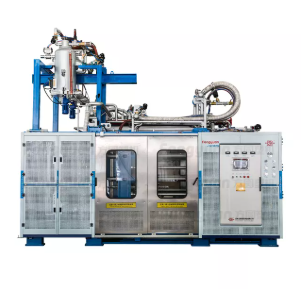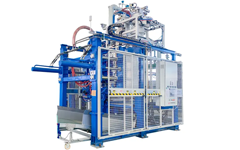- All
- Product Name
- Product Keyword
- Product Model
- Product Summary
- Product Description
- Multi Field Search
Views: 4 Author: Site Editor Publish Time: 2025-07-08 Origin: Site








EPP shape molding machines are revolutionizing the toy manufacturing industry. But what exactly makes them essential? These machines offer unmatched precision and efficiency, making toy production faster and more cost-effective.
In this post, Hangzhou Fangyuan Plastics Machinery.Ltd’ll explore the benefits of EPP shape molding machines and why they are critical to producing high-quality toys.
Expanded Polypropylene (EPP) is a type of foam that’s widely used in toy manufacturing. It’s a lightweight yet durable material, known for its excellent shock absorption properties. Unlike other foam materials, EPP is highly resistant to impacts, making it a favorite for applications requiring durability, such as in automotive parts and packaging. This foam can be molded into various shapes, which makes it ideal for creating different types of toys.
Characteristics of EPP Foam:
● Lightweight: Despite its strength, EPP foam is incredibly light, making it easy to handle and transport.
● Durable: EPP is resistant to wear and tear, making it last longer even under harsh conditions.
● Impact-resistant: Its unique structure allows it to absorb shocks, preventing damage to the molded product.
EPP foam has various uses across multiple industries. In addition to toy manufacturing, it’s widely used in:
● Automotive: Used in car bumpers and other energy-absorbing parts.
● Packaging: Provides protective packaging for fragile items, such as electronics and glass products.
● Toys: Its light weight and durability make it perfect for producing children’s toys.

EPP shape molding machines are designed for precision and efficiency. These machines ensure that each molded toy is consistent and meets quality standards. The precise control of temperature and pressure during the molding process helps ensure that the foam material is perfectly formed, allowing manufacturers to create complex toy designs with ease.
Importance of Temperature and Pressure Control:
● Maintaining accurate temperature and pressure levels is critical for achieving the desired mold characteristics.
● These settings help avoid issues like uneven surfaces or structural weakness in the toys.
Automation is a key feature in modern EPP shape molding machines. By reducing the need for manual intervention, these machines increase production rates and reduce human error. Automated systems can operate continuously, improving efficiency and reducing downtime.
EPP shape molding machines offer a high degree of flexibility. Manufacturers can easily customize molds to produce a wide range of toy designs. The machines are equipped with multiple cavities, allowing for the production of several toys at once. Additionally, operators can adjust settings to cater to different toy sizes, shapes, and material types.
The EPP molding process involves several steps:
1. Feeding: The foam material is loaded into the machine.
2. Heating: The material is heated to soften it, preparing it for molding.
3. Molding: The softened material is injected into a mold and shaped.
4. Cooling: The mold is cooled to solidify the foam.
5. Releasing: The finished product is removed from the mold.
Each of these steps requires precise control over temperature, pressure, and steam flow to achieve the desired product quality.
The operation of EPP molding machines is controlled through sophisticated control panels. These panels allow operators to monitor and adjust parameters such as pressure and temperature. Many machines also feature built-in safety features, including emergency stop buttons and alarms, which help prevent accidents and ensure smooth operation.
The integration of automated systems in molding machines has revolutionized toy production. Automation improves product consistency and quality while reducing costs. By eliminating human error, automated systems ensure that every toy meets strict safety and quality standards.

One of the key benefits of EPP shape molding machines is their cost-effectiveness. These machines reduce material waste by ensuring that only the required amount of foam is used during the molding process. Furthermore, their high efficiency and fast production cycles allow manufacturers to meet high demand while keeping costs low.
Reducing Material Waste:
● With precise control over the amount of foam used, less material is wasted during production.
● Efficient heating and cooling systems also minimize energy consumption.
High-quality EPP molding machines can produce large volumes of toys in a short time. The ability to adjust settings for different molds ensures that production can be scaled up or down based on demand. This flexibility is essential for manufacturers dealing with fluctuating toy orders.
EPP shape molding machines are built to last. They are equipped with high-strength frames and advanced hydraulic pressure systems that ensure stability and reliability during operation. These features make the machines suitable for high-volume production, where uptime is critical.
EPP foam is used to manufacture various types of toys, including:
● Toy blocks: Lightweight and durable, making them easy for children to handle.
● Action figures: The foam’s shock-absorbing properties help protect the figures from damage.
● Outdoor toys: EPP foam’s resilience to impacts makes it ideal for outdoor toys like frisbees and flying discs.
Impact of EPP in Toy Safety:
● EPP foam makes toys safer for children by reducing the risk of injury.
● Its lightweight and durable nature ensure that toys can withstand rough play without breaking.
One of the major advantages of using EPP molding machines in toy manufacturing is the ability to customize designs. Whether it’s creating intricate toy figures or large foam structures, the machine’s ability to adjust for different mold types makes it easy to meet specific design requirements.
Choosing the right EPP shape molding machine depends on several factors:
● Machine Size: Ensure that the machine is capable of handling the size of toys you plan to produce.
● Cavity Design: Choose machines that offer the flexibility to create different shapes and sizes.
● Material Compatibility: Ensure the machine is compatible with EPP foam and other materials you may need to use.
When selecting a machine, consider the following features:
● Temperature and Pressure Control: Look for machines that allow precise control of temperature and pressure for consistent output.
● High-Strength Frame: A durable frame ensures the machine can withstand the stresses of high-volume production.
● Safety Mechanisms: Choose machines with built-in safety features, such as emergency stop buttons and remote control systems.
It’s important to purchase molding machines from reputable manufacturers who offer after-sales support. Look for machines that have certifications like ISO9001:2015, ensuring that they meet international quality standards.
Proper maintenance is crucial to prolong the life of your EPP molding machine. Regular cleaning and inspection of the hydraulic and pneumatic systems are essential to avoid wear and tear.
Common issues with EPP molding machines include inconsistent temperature control, pressure fluctuations, and mold jamming. Regular maintenance and timely troubleshooting can prevent these problems from affecting production.
Having access to reliable spare parts and technical support is vital for minimizing downtime. Ensure that the manufacturer provides robust after-sales services to address any issues that arise during operation.
The future of EPP shape molding machines looks bright with advancements in technology. Features like AI integration and energy-saving systems are making these machines even more efficient and environmentally friendly.
As the demand for eco-friendly products grows, EPP shape molding machines are at the forefront of sustainable toy manufacturing. By using recyclable materials like EPP foam, toy manufacturers can meet consumer demand for greener products while maintaining high-quality production.
High-quality EPP shape molding machines play a crucial role in toy manufacturing. They offer precision, efficiency, and scalability while reducing costs. These machines help create durable and safe toys, making them ideal for high-volume production. Investing in top-notch EPP molding machines is a smart choice for toy manufacturers seeking sustainable growth and improved production efficiency.
A: EPP (Expanded Polypropylene) is lightweight, durable, and impact-resistant, ideal for creating shock-absorbing products. EPS (Expanded Polystyrene) is more rigid and less flexible, typically used for packaging. EPP is better suited for applications requiring durability and impact resistance, such as toys and automotive parts.
A: Yes, EPP molding machines are widely used in automotive (e.g., bumpers), packaging (e.g., protective packaging), and furniture industries. The machines' ability to mold complex shapes makes them versatile across various sectors.
A: Regular cleaning, inspection of hydraulic and pneumatic systems, and timely adjustments to pressure and temperature controls are essential. Maintenance schedules depend on usage frequency but should generally occur every few months.
A: Consider machine size, cavity design, and material compatibility. Evaluate speed and efficiency for your production goals and ensure the machine meets safety standards and offers after-sales support from reputable manufacturers.
A: Yes, modern EPP molding machines are designed with energy-saving features, such as efficient heating and cooling systems. These features help reduce energy consumption while maintaining high production efficiency.